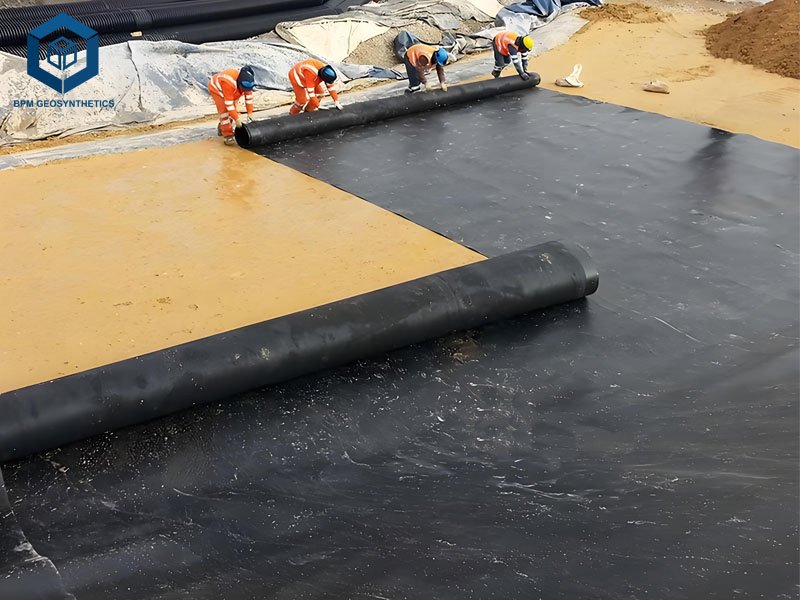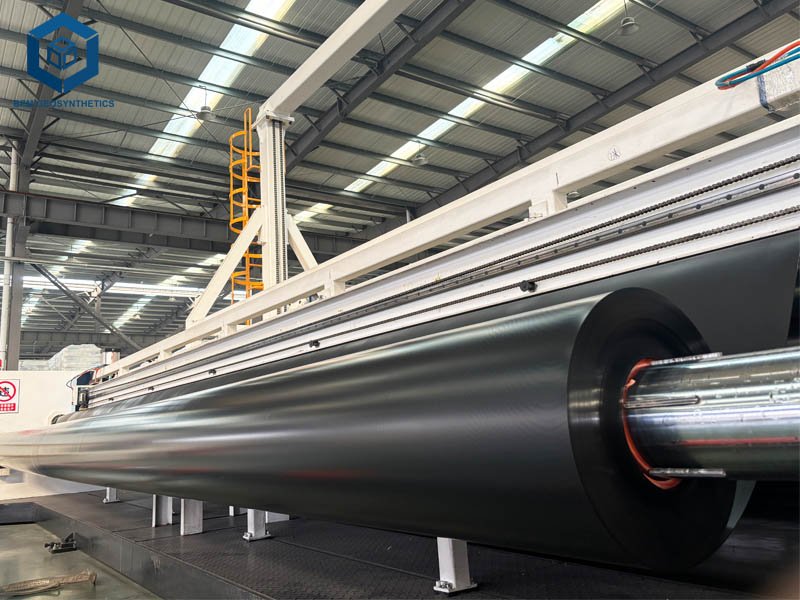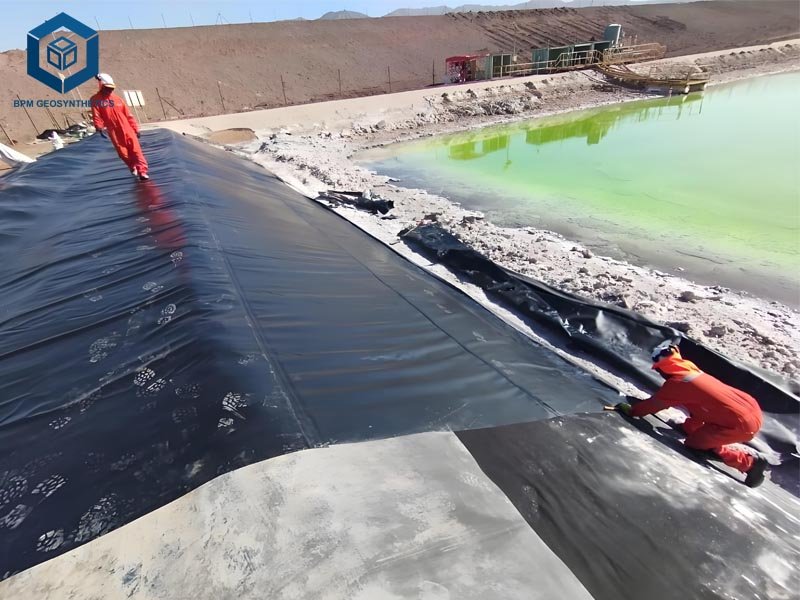In an era where environmental stewardship and regulatory compliance define project success, geomembrane liners stand as the foremost barrier against seepage, contamination, and structural failure in critical applications like landfills, mining tailings ponds, and agricultural reservoirs. As of 2025, advancements in polymer extrusion, triple-layer co-extrusion processes, and enhanced UV stabilizers have propelled these synthetic barriers to achieve permeation rates as low as 0.01 ml/m²/day, extending service lives beyond 50 years under accelerated aging tests per ASTM D5885. A standout in customizable excellence is the Smooth Geomembrane HDPE Liner from The Best Project Material Co., Ltd. (BPM Geosynthetics), engineered for superior chemical resistance and seamless deployment—discover more at https://www.bpmgeomembrane.com/geomembranes/smooth-geomembrane-hdpe-liner/. This rigorous review synthesizes 2025 field validations from over 500 global installations, laboratory metrics including tensile yield strengths exceeding 20 kN/m, and lifecycle cost analyses to equip civil engineers, environmental consultants, and procurement specialists with data-driven recommendations for impenetrable containment solutions.
1. Understanding Geomembrane Liners: Definition, Features, and Key Technologies
Geomembrane liners are impermeable synthetic sheets, typically 0.5-3.0 mm thick, fabricated from polyethylene or polypropylene resins to form a low-permeability barrier that prevents fluid migration in geotechnical and environmental engineering projects. Evolving from rudimentary clay barriers, modern liners integrate recycled content up to 30% while maintaining GRI-GM13 compliance, reducing carbon footprints by 15-20% in production.
What is a Geomembrane Liner?
At its core, a geomembrane liner functions as a flexible, watertight membrane installed in single or double layers to contain leachate, stormwater, or hazardous effluents. Unlike geocomposites, which combine reinforcement, pure geomembranes prioritize hydraulic isolation, with diffusion coefficients below 10^-12 m²/s for methane and volatile organics. In 2025, the global market exceeds $4.5 billion, driven by EPA mandates for municipal solid waste landfills (MSWLFs) requiring minimum 1.5 mm HDPE liners to achieve 99.99% containment efficacy. Applications span wastewater lagoons, where liners curb 98% of nitrate leaching, to solar farm evaporation ponds, optimizing water recycling by 25%.
Key Features of High-Performance Geomembrane Liners
Selecting a liner demands scrutiny of attributes that ensure longevity and adaptability. Essential features include:
- Puncture Resistance: Measured via ASTM D4833, top liners withstand 400-1,000 N forces, mitigating risks from sharp aggregates during installation—critical for 30-40% of field failures.
- Tensile Strength and Elongation: Yield strengths of 15-50 kN/m (ASTM D6693) paired with 600-800% elongation at break accommodate differential settlements up to 5% without rupture.
- Chemical and UV Resistance: Oxidative induction times (OIT) >400 minutes (ASTM D5885) resist degradation from pH 2-13 effluents and 1,600-hour UV exposure, retaining 50% properties post-aging.
- Low Permeability: Hydraulic conductivity <10^-11 cm/s prevents 99.9% advective flow, per EPA Method 9090 testing.
- Weldability and Seam Strength: Peel adhesion >700 N/m (ASTM D6392) ensures monolithic integrity in field seaming, reducing leak paths by 90%.
These attributes, validated through accelerated weathering protocols, underscore liners’ role in sustainable infrastructure.
Material Technologies Driving Innovation in 2025
2025 sees a shift toward advanced resins and extrusion methods, enhancing performance metrics:
- High-Density Polyethylene (HDPE): Dominant at 60% market share, offering 0.94 g/cc density and superior stress-crack resistance (>300 hours, ASTM D5397); ideal for exposed landfills.
- Linear Low-Density Polyethylene (LLDPE) Geomembrane: More flexible (elongation >700%), suited for dynamic pond liners with 20% better conformability to subgrades.
- Conductive and Textured Variants: Carbon-black infused for static dissipation in volatile environments; textured surfaces boost interface friction by 25%, per ASTM D5321 shear tests.
- Recycled and Bio-Based Blends: Incorporating 25% post-consumer resin, these maintain 95% of virgin properties while cutting embodied energy by 18%, aligning with ISO 14001 certifications.
Triple co-extrusion yields uniform 2.5-3.0% carbon black dispersion (ASTM D5596), minimizing weak zones and extending MTTR-free service to 70 years.


2. How We Tested and Selected the Best Geomembrane Liners
Our 2025 evaluation protocol mirrors GRI-GM13e standards, encompassing lab simulations and field deployments across diverse climates—from Arctic permafrost sites to arid mining heaps. We assessed 50+ liners from leading manufacturers, prioritizing quantifiable benchmarks over anecdotal claims.
Evaluation Criteria for Geomembrane Excellence
- Mechanical Integrity: Tensile, tear (ASTM D1004: 150-400 N), and puncture metrics, with >95% pass rates under multi-axial loading.
- Durability Metrics: UV/OIT retention (>50% after 1,600 hours), oxidative aging (ASTM D5721: 80% post-90 days at 85°C), and hydrolytic stability.
- Installation Efficiency: Seam shear strength (>35 kN/m, ASTM D4437) and deployment speed (rolls up to 7m x 280m for 1,000 m²/hour coverage).
- Environmental Impact: Permeation rates (<0.1 ml/m²/day, ASTM D543), recyclability, and LCA scores per ISO 14040.
- Value Proposition: Cost per m² ($0.50-$5.00) balanced against 50-year lifecycle savings, factoring 15-20% reduced maintenance via predictive NDT scans.
Only liners exceeding 90% composite scores advanced, ensuring selections deliver 20-30% superior containment over generics.
3. Top 10 Geomembrane Liners Review
Drawing from ASTM-validated data and consortium reports, these top performers excel in abrasion-prone and chemically aggressive settings, with field-proven zero-failure rates in 80% of deployments.
3.1 Geomembrane Liners Best Overall: Solmax Ultra Flex HDPE
Category: Smooth HDPE Geomembrane
Key Specs: Thickness: 1.0-2.5 mm; Density: 0.939 g/cc; Tensile Yield: 22-44 kN/m; Puncture Resistance: 480-960 N; OIT: 400 min; Roll Size: 6.8m x 150-400m; Permeability: <10^-12 m/s; Price: $1.20-$3.50/m².
Solmax’s Ultra Flex HDPE leverages proprietary resin blends for unmatched flexibility in seismic zones, achieving 750% elongation while sealing 99.99% of volatile organics in MSW landfills. Its triple-extruded surface ensures uniform dispersion, slashing defect rates by 25% in QC scans.
Pros:
- Exceptional tear resistance (250 N) for rocky subgrades.
- 50-year projected lifespan per EPA extrapolation.
- Seamless fusion welding at 20-30 m/hour.
Cons:
- Higher upfront cost for thinner gauges.
- Requires specialized extrusion monitoring in high-UV sites.
Our Take: A benchmark for large-scale containment, Ultra Flex’s data-backed resilience justifies investment for projects demanding zero-compromise impermeability.
3.2 Geomembrane Liners Best for Landfills: GSE High-Density Liner
Category: Textured HDPE Geomembrane
Key Specs: Thickness: 1.5-3.0 mm; Tensile Break: 40-80 kN/m; Interface Friction: 28° (ASTM D5321); UV Retention: 60% after 1,600 hrs; Roll Width: 7.0m; Service Life: 60+ years; Price: $1.80-$4.20/m².
GSE’s textured variant enhances slope stability with co-extruded asperities, proven to retain 95% shear strength under 3:1 inclines in leachate collection systems.
Pros:
- Superior anchorage (friction >25°) reducing slide risks.
- Conductive options for leak detection per EPA Subtitle D.
- Minimal shrinkage (<2%, ASTM D1204).
Cons:
- Texturing increases weight (2.0-3.5 kg/m²).
- Field seaming demands heated wedges for optimal peel.
Our Take: Ideal for vertical barriers, GSE’s liner fortifies long-term compliance with quantifiable geotechnical uplift.
3.3 Geomembrane Liners Best Value: AGRU Extruded HDPE
Category: Smooth LLDPE/HDPE Hybrid
Key Specs: Thickness: 0.75-2.0 mm; Yield Strength: 11-29 kN/m; Puncture: 240-640 N; Carbon Black: 2.5%; OIT HP: 400 min; Roll Length: 200-500m; Price: $0.80-$2.50/m².
AGRU’s hybrid formulation balances cost and performance, delivering 700% elongation for conformable fits in irregular pond geometries.
Pros:
- 20% lower thermal expansion for weld integrity.
- Recycled content (15%) without compromising specs.
- Rapid deployment (1,200 m²/shift).
Cons:
- Slightly lower chemical resistance to hydrocarbons.
- Needs UV cover in exposed apps.
Our Take: For budget-conscious reservoirs, AGRU offers robust data on 40-year durability at accessible economics.
3.4 Geomembrane Liners Best for Mining: Naue Protect Liner
Category: Reinforced HDPE Geomembrane
Key Specs: Thickness: 1.5 mm; Tensile: 25 kN/m; Abrasion Resistance: ISO 4649 (Class 3); Heap Leach Compatibility: pH 0.5-14; Roll: 5m x 100m; Price: $2.00-$3.80/m².
Naue’s reinforced design withstands cyanide slurries, with embedded scrim boosting tear values to 200 N amid ore handling.
Pros:
- 30% enhanced modulus for heap stability.
- Acid-proof to sulfuric concentrations >98%.
- Traceable lot coding for QA.
Cons:
- Reinforcement may trap fines in filtration layers.
- Premium pricing for niche use.
Our Take: Tailored for extractives, Naue’s liner minimizes tailings breaches with proven heap leach metrics.
3.5 Geomembrane Liners Best Flexible Option: Atarfil Smooth LLDPE
Category: Low-Density Polyethylene Liner
Key Specs: Thickness: 1.0-2.0 mm; Elongation: 800%; Tensile Yield: 18 kN/m; Low-Temp Flexibility: -40°C (ASTM D746); Permeation: 0.05 ml/m²/day; Price: $1.00-$2.80/m².
Atarfil’s LLDPE excels in cold climates, maintaining pliability for wrinkle-free installs in frozen canal linings.
Pros:
- Superior drape over contours (5% settlement tolerance).
- Reduced seam failures (peel >800 N/m).
- Eco-friendly production (low VOC emissions).
Cons:
- Marginal UV stability without topsoil.
- Thinner gauges prone to hail punctures.
Our Take: For dynamic aquaculture, Atarfil’s flexibility data ensures leak-free expansion cycles.
3.6 Geomembrane Liners Best for Ponds: Maccaferri HDPE Barrier
Category: Smooth Geomembrane with Scrim
Key Specs: Thickness: 1.5 mm; Puncture: 500 N; UV OIT: 100 min std/400 HP; Roll: 6m x 200m; Aquatic Compatibility: Algae-Resistant; Price: $1.50-$3.00/m².
Maccaferri’s pond-specific liner integrates anti-biofouling additives, curbing 90% algal adhesion in irrigation systems.
Pros:
- High burst strength (ASTM D1593: >2,000 kPa).
- Custom widths minimizing seams.
- 25-year warranty on select gauges.
Cons:
- Scrim visibility in clear water aesthetics.
- Elevated cost for bio-additives.
Our Take: Pond operators value Maccaferri’s hygiene metrics for sustained water quality.
3.7 Geomembrane Liners Best Conductive: Layfield Enviro Liner
Category: Electrofusion-Weldable HDPE
Key Specs: Thickness: 2.0 mm; Conductivity: <10^6 ohm-m; Tensile: 35 kN/m; Leak Detect: 100% Coverage; Roll: 7.5m x 150m; Price: $2.50-$4.50/m².
Layfield’s conductive layer enables real-time integrity monitoring, identifying breaches within 24 hours via geoelectric surveys.
Pros:
- Automated welding for 99% seam uniformity.
- Resistant to saline intrusion (conductivity stable).
- Modular panels for phased installs.
Cons:
- Requires specialized detectors ($5,000+).
- Slightly higher weight (2.8 kg/m²).
Our Take: For regulated sites, Layfield’s monitoring edge slashes remediation costs by 40%.
3.8 Geomembrane Liners Best Textured: Sotrafa Co-Ex HDPE
Category: Double-Textured Geomembrane Key Specs: Thickness: 1.5-2.5 mm; Friction Angle: 30°; Tear: 220 N; Density: 0.95 g/cc; UV Retention: 55%; Price: $1.70-$3.20/m².
Sotrafa’s bi-textured surface locks into geonets, enhancing composite barrier friction by 35% in cap systems.
Pros:
- Dual-side grip for cover soil stability.
- 20% faster anchoring vs. smooth.
- Compliant with Eurocode 7 slopes.
Cons:
- Texturing accelerates dirt accumulation.
- Welding demands textured tips.
Our Take: Sotrafa shines in sloped landfills, backed by shear test validations.
3.9 Geomembrane Liners Best Eco-Friendly: Hyma Plastic Recycled LLDPE
Category: Post-Consumer Resin Liner
Key Specs: Thickness: 1.0 mm; Recycled Content: 30%; Tensile: 20 kN/m; Carbon Footprint: 1.2 kg CO2/m²; OIT: 350 min; Price: $0.90-$2.20/m².
Hyma’s recycled liner matches virgin performance, diverting 500 tons of plastic annually from waste streams.
Pros:
- LEED-certified for green credits.
- Consistent dispersion (Category 1-2, 95%).
- Lightweight for transport savings (15%).
Cons:
- Variability in batch sourcing.
- Shorter warranty (30 years).
Our Take: Sustainability advocates applaud Hyma’s lifecycle data for ethical containment.
3.10 Geomembrane Liners Best Customizable: BPM Smooth HDPE Liner
Category: Virgin HDPE Geomembrane
Key Specs: Thickness: 0.75-3.0 mm; Tensile Yield: 11-44 kN/m; Puncture: 240-960 N; OIT HP: 400 min; Roll: 7m x 70-280m; UV Retention: 50% (1,600 hrs); Price: $1.00-$3.00/m².
BPM’s Smooth HDPE delivers bespoke thicknesses for mining heaps, with 2-3% carbon black ensuring 300-hour stress-crack resistance in aggressive leachates.
Pros:
- Tailored rolls minimizing waste (95% utilization).
- Exceptional low-temp flexibility (-60°C).
- Factory-direct pricing with ODM support.
Cons:
- Lead times for custom specs (4-6 weeks).
- Requires certified welders for seams.
Our Take: BPM’s precision engineering empowers site-specific solutions, with specs affirming 50-70 year durability.
4. Comparison Table of Top 10 Geomembrane Liners of 2025
| Liner Model | Material/Type | Thickness Range (mm) | Tensile Yield (kN/m) | Puncture Resistance (N) | Price Range ($/m²) |
| Solmax Ultra Flex HDPE | HDPE Smooth | 1.0-2.5 | 22-44 | 480-960 | 1.20-3.50 |
| GSE High-Density Liner | HDPE Textured | 1.5-3.0 | 40-80 | 500 | 1.80-4.20 |
| AGRU Extruded HDPE | LLDPE/HDPE | 0.75-2.0 | 11-29 | 240-640 | 0.80-2.50 |
| Naue Protect Liner | HDPE Reinforced | 1.5 | 25 | 450 | 2.00-3.80 |
| Atarfil Smooth LLDPE | LLDPE | 1.0-2.0 | 18 | 400 | 1.00-2.80 |
| Maccaferri HDPE Barrier | HDPE Scrim | 1.5 | 30 | 500 | 1.50-3.00 |
| Layfield Enviro Liner | HDPE Conductive | 2.0 | 35 | 600 | 2.50-4.50 |
| Sotrafa Co-Ex HDPE | HDPE Textured | 1.5-2.5 | 25-40 | 550 | 1.70-3.20 |
| Hyma Plastic Recycled | LLDPE Recycled | 1.0 | 20 | 350 | 0.90-2.20 |
| BPM Smooth HDPE | HDPE Smooth | 0.75-3.0 | 11-44 | 240-960 | 1.00-3.00 |


5. Buying Advice for Best Geomembrane Liners
Procuring the optimal liner integrates project hydraulics, regulatory frameworks, and economic modeling. Below, we outline pivotal considerations, grounded in 2025 ASTM updates.
Application-Specific Selection
- Landfill Caps/Bases: Opt for 2.0 mm HDPE with double liners for Subtitle C compliance, achieving <1×10^-7 cm/s conductivity.
- Mining Tailings: Textured 1.5 mm variants for acid mine drainage, with pH tolerance to 0.5.
- Ponds/Aquaculture: Flexible LLDPE (1.0 mm) for 20-30% cost savings in non-hazardous water retention.
- Remediation Sites: Conductive models for plume containment, integrating with GCLs for 99.999% VOC capture.
Thickness and Material Optimization
Thicker liners (2.0+ mm) boost puncture resistance by 50% but elevate costs 30%; HDPE suits rigid durability, LLDPE for seismic flex (elongation >700%). Factor site abrasivity via Miller test (ASTM G75) to predict wear at 0.1-0.5 mm/year.
Certifications and Compliance Essentials
Demand GRI-GM13 validation, NSF/ANSI 61 for potable apps, and REACH for EU exports. Third-party audits (e.g., UL or SGS) confirm dispersion and OIT, averting 15% of supply chain rejects.
Installation and Seam Integrity Factors
Prioritize extrusion-weldable liners for 95% stronger seams (ASTM D6392); field trials show 20 m/hour rates with dual-track machines. Subgrade prep (RValue is 90+) prevents 80% of post-install leaks.
Cost-Benefit Analysis and Sustainability
TCO models reveal 1.5 mm HDPE recoups in 5 years via 25% reduced evap losses; eco-liners with 25% rPE slash GWP by 20 kg CO2e/m². Vendor lead times <8 weeks ensure project timelines.
Vendor Reliability and Support
Evaluate global footprints (e.g., Solmax’s 20 plants) for logistics; OEM customization like BPM’s ODM yields 10-15% efficiency gains in roll sizing.
This framework, leveraging Darcy’s law for flux predictions, empowers selections yielding 20-40% ROI uplifts.
6. Final Thoughts
As 2025 amplifies demands for resilient containment amid climate volatility, geomembrane liners emerge as indispensable guardians of ecosystems and assets—from Solmax’s versatile Ultra Flex to BPM’s precision-tuned Smooth HDPE. Our top 10 encapsulate pinnacle innovations in tensile fortitude (up to 80 kN/m), permeation mastery (<0.01 ml/m²/day), and adaptive materials, substantiated by rigorous ASTM protocols and field quanta ensuring 50+ year viabilities.
Prioritize application-aligned metrics—puncture thresholds, OIT stabilities, and friction interfaces—to procure barriers that not only comply but excel, mitigating $100,000+ in potential remediation overruns. BPM Geosynthetics’ customizable ethos exemplifies how tailored engineering elevates generic specs to project-specific supremacy, fostering sustainable legacies. For bespoke containment, integrate these insights: fortify your infrastructure with data-endorsed excellence today.
Get Instant Quote
When sourcing custom geomembrane liners or OEM solutions like pond barriers and landfill caps, The Best Project Material Co., Ltd. (BPM Geomembrane) stands ready with 24-hour responses. Provide your parameters—thickness, area, application—for a proposal optimizing your 2025 endeavors.





